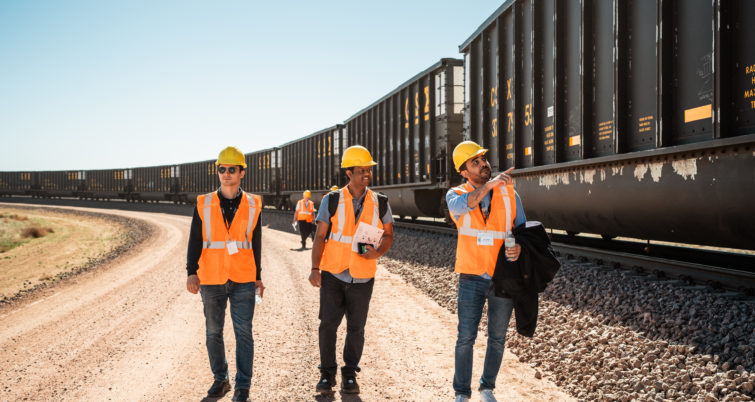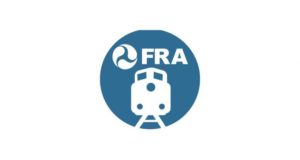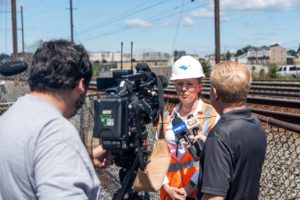29th Annual AAR Research Review Round-Up
Written by Jennifer McLawhorn, Managing Editor
PUEBLO, Colo. – As one of the sponsors for the 29th Annual AAR Research Review hosted by MxV Rail, RT&S headed to Pueblo.
From April 23rd to 25th, MxV Rail hosted the 29th Annual AAR Research Review at the Pueblo Convention Center in Pueblo, Colorado. Over the course of a few days, attendees had the opportunity to network, attend infrastructure and/or mechanical sessions, and attend a track walk at MxV Rail’s new FAST Loop.


The first full day of the conference opened with keynote speaker Ed Boyle, Vice President of Engineering at Norfolk Southern. Boyle warmed up the crowd whilst commenting that he “couldn’t be more proud of the accomplishments made by the Norfolk Southern Engineering Team.” Shortly after, MxV Rail AVP Research and Innovation Scott Cumming went over the SRI (Strategic Research Initiatives) vision and mission.
Given Railway Track & Structures‘ namesake, I attended both infrastructure sessions from SRI teams. The first infrastructure session covered “Evaluation of Rail and Weld Integrity” from Principal Investigator II Anaya Banerjee, PhD., “Crosstie and Fastener Research” from Principal Investigator I Yin Gao, PhD., and “Bridge Research” from Scientist Chris Johnson.

“Evaluation of Rail and Weld Integrity” from Banerjee focused on evaluating wear and fatigue of latest high strength and intermediate strength rails and effects of cold weather on rail performance. According to the presentation, no internal defects were observed in the head or base of any rails, but they did see weld breaks on low rail. Rolling Contact Fatigue (RCF) on low rail was caused by false flange contact.

Additionally, the presentation included an analysis of vertical electric flash butt weld features. At MxV Rail’s high-speed loop (HSL), three failures were observed at less than 2 MGT. Macro etching revealed flow lines and alloy segregation.
“Crosstie and Fastener Research” from Gao looked at evaluating the performance of new and existing ties and fastener designs. The first test looked at laboratory spike pullout tests where all tested materials met AREMA recommendations. The presentation also looked at a spike breakage study and a wood tie life study. In the spike breakage study, this looked at the different operating conditions, fastener types, train types, and speeds. The wood tie life study was in collaboration with BNSF.
“Bridge Research” from Johnson sought to develop, evaluate, and implement new bridge design and maintenance strategies. It also evaluated legacy bridge designs. During the presentation, Johnson covered Member Level Redundancy (MLR), or the concept that the presence of multiple cover plates, as well as flange angles, provides a level of redundancy within a built-up steel girder bridge tension member.

After lunch, the second Infrastructure session covered “Revenue Service Testing” from Scientist Duane Otter, PhD., “Subgrade and Ballast Research” from Principal Investigator I Steve Wilk, PhD., and “Machine Learning Approach to Ultrasonic A-Scans for Rail Flaw Detection” from Principal Investigator II Anish Poudel, PhD.
“Revenue Service Testing” presented an evaluation of new designs, methods, and components in revenue service. There was a Frog profile performance evaluation on a Norfolk Southern line south of Cincinnati and an analysis of CWR behavior near a turnout. The revenue service tests are ongoing for a number of infrastructure issues that range from rail to subgrade, and these complement the studies performed at FAST. Otter finished by saying results for these tests could be found in an upcoming Technology Digest.
“Subgrade and Ballast Research” from Wilk sums up the development of full lateral track strength compaction curve by combining new and existing datasets. According to Wilk’s presentation, this curve is a tool that can be used to understand anticipated lateral track strength at various tonnage increments.
“Machine Learning Approach to Ultrasonic A-Scans for Rail Flaw Detection” from Anish Poudel covered Machine Learning (ML), research motivation, a current approach to rail flaw detection, Ultrasonic A-Scan, Data Library, and ML as a baseline model, and a look at the path forward.
The sessions concluded with three presentations on vehicle/track interaction research: “Communications and Train Control” from Alejandro Gonzalez-Ruiz, “Speed Restrictions in Hot Weather” from Stephen Wilk and Walter Rosenberger, and “Wheel and Rail Profile Research” from Ulrich Spangenberg.
The next morning, Senior AVP Operations for MxV Rail Shawn Vecellio briefed the attendees on what to expect during the track walk. As soon as we were geared up with high-vis vests, safety glasses, and hard hats and fitted ourselves with steel-toe boots, we gathered onto buses to head toward MxV’s FAST Loop.

Reading and writing about track infrastructure is one thing. Seeing and touching it is another. This author had the privilege of walking in the morning with rail consultant (formerly with Norfolk Southern) Brad Kerchof who took the time to point out tie types, fastener types, the difference between oil-based and water-based friction management solutions, among many other components of rail and track infrastructure.


Along the track were a plethora of tests, measurement systems, demonstrations, and experts talking about their research. Below is a list from MxV Rail that includes everything at the track walk.
- Rail/Special Trackwork
- High Strength/Premium Rail Test
- Intermediate Strength Rail Test
- OWLS Crossing Diamond
- Turnout with Lift Frog Tie and Fastener
- Concrete/Timber Interspersed Tie Research
- Timber Tie Fastener Research
- Concrete Ties with Under Tie Pads
- Post Tension Concrete Tie Research Inspection/Detection/Analysis
- Rail Temperature & Stress Measurements
- Hot Wheel/Hot Bearing Detector
- Dragging Equipment Detector
- Truck Performance Measurements
- Continuous Track Geometry Measurement
- Alternative Broken Rail Detection – On Board System
- Alternative Broken Rail Detection – Track Based System
- EMAT Wheel Inspection System
- FIRST System Demonstration
- Wheel Impact Load Measurement
- Level 1 Sponsor Loram – 3D Surface and Automated Tie Painting
- Level 2 Sponsor Athena Industrial – Rail Surface Inspection
- Level 2 Sponsor Holland – Mobile Welder and Track Inspection System
- Level 2 Sponsor Plasser – UT Rail Inspection System
- Level 2 Sponsor Railmetrics – Track Inspection System Bridge
- Bridge Deck Research
- Bridge Span Research
- Bridge Approach Research Rolling Stock Performance
- High Performance Wheel Test
- Draft System Research
- Railcar Parking Brake Evaluation
Every other month, MxV Rail is published in Railway Track & Structures magazine. To read more from MxV Rail, readers are encouraged to catch up on our digital issues which can be found here.




